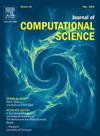通过对锌天然产物数据库的计算机筛选,获得了针对2型糖尿病肾衰竭的新发现
IF 3.7
3区 计算机科学
Q2 COMPUTER SCIENCE, INTERDISCIPLINARY APPLICATIONS
引用次数: 0
摘要
肾功能不全是2型糖尿病(T2DM)患者常见的潜在致命后果。这种并发症的严重性因其进展而导致死亡的可能性增加而更加突出。因此,优先预防肾功能损害的进展至关重要。钠-葡萄糖共转运蛋白2 (SGLT2)抑制剂在延缓肾功能障碍和蛋白尿进展方面的功效已被证实,强调了它们在肾脏问题管理中的潜在效用。为了发现天然的SGLT2抑制剂,开展了一项全面的研究,包括基于结构的虚拟筛选和一系列工具,通过广泛的锌数据库进行分离。通过药效团模型的应用,从锌数据库中识别出11336种可能作为SGLT2抑制剂的天然化合物。通过对ADME(吸收、分布、代谢和排泄)属性、口服生物利用度、分子动力学参数以及与已批准抑制剂的类似对接亲和力的严格评估,筛选出了两种化合物。化合物580是一个很有希望的候选者,因为它与代谢过程一致,并且没有对心脏毒性作用的倾向。本研究的发现有助于加强SGLT2抑制剂的有效性,从而为全面的体外和体内实验铺平道路。同时,这些结果作为新型抑制剂创新的催化剂,预示着一个新的可能性时代。本文章由计算机程序翻译,如有差异,请以英文原文为准。
Novel hits for targeting kidney failure in type 2 diabetes derived via in silico screening of the ZINC natural product database
Renal dysfunction is a common and potentially fatal consequence often noticed in persons who have been diagnosed with type 2 diabetes mellitus (T2DM). The gravity of this complication is underscored by the heightened likelihood of death linked to its advancement. Therefore, it is crucial to prioritize the prevention of the progress of renal impairment. The efficacy of sodium-glucose cotransporter 2 (SGLT2) inhibitors in retarding the advancement of renal dysfunction and albuminuria has been demonstrated, underscoring their potential utility in the management of renal problems. In a quest to unearth natural SGLT2 inhibitors, a comprehensive study was undertaken, encompassing structure-based virtual screening and a range of tools deployed to separate through the extensive ZINC database. Through the application of a pharmacophore model, a cohort of 11,336 natural compounds were discerned from the ZINC database that could potentially serve as SGLT2 inhibitors. Amid this collection, two compounds were singled out via a rigorous assessment of ADME (absorption, distribution, metabolism, and excretion) attributes, oral bioavailability, molecular dynamics parameters, and akin docking affinities to approved inhibitors. Compound 580 emerged as a promising candidate, validated by its congruence with metabolic processes and the absence of proclivities toward cardiotoxic effects. The findings from this investigation serve to reinforce the validation of SGLT2 inhibitors, thus paving the way for comprehensive in vitro and in vivo experimentation. Concurrently, these outcomes act as a catalyst for the innovation of novel inhibitors, heralding a new era of possibilities.
求助全文
通过发布文献求助,成功后即可免费获取论文全文。
去求助
来源期刊

Journal of Computational Science
COMPUTER SCIENCE, INTERDISCIPLINARY APPLICATIONS-COMPUTER SCIENCE, THEORY & METHODS
CiteScore
5.50
自引率
3.00%
发文量
227
审稿时长
41 days
期刊介绍:
Computational Science is a rapidly growing multi- and interdisciplinary field that uses advanced computing and data analysis to understand and solve complex problems. It has reached a level of predictive capability that now firmly complements the traditional pillars of experimentation and theory.
The recent advances in experimental techniques such as detectors, on-line sensor networks and high-resolution imaging techniques, have opened up new windows into physical and biological processes at many levels of detail. The resulting data explosion allows for detailed data driven modeling and simulation.
This new discipline in science combines computational thinking, modern computational methods, devices and collateral technologies to address problems far beyond the scope of traditional numerical methods.
Computational science typically unifies three distinct elements:
• Modeling, Algorithms and Simulations (e.g. numerical and non-numerical, discrete and continuous);
• Software developed to solve science (e.g., biological, physical, and social), engineering, medicine, and humanities problems;
• Computer and information science that develops and optimizes the advanced system hardware, software, networking, and data management components (e.g. problem solving environments).
 求助内容:
求助内容: 应助结果提醒方式:
应助结果提醒方式:


